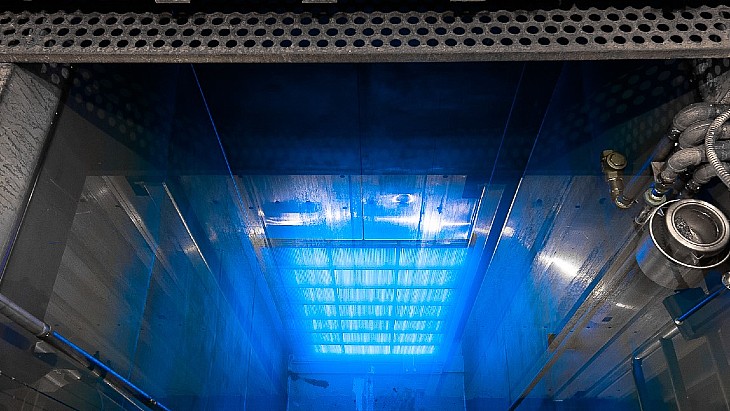
The radioisotope cobalt-60 that is manufactured in some nuclear reactors is used to sterilise approximately 40% of single-use medical devices globally. These devices include items such as syringes, catheters, IV sets, surgical gloves and gauze used in a wide range of health care applications. A patient in surgery or receiving wound care or simply having a blood sample taken, is highly likely to be treated using products that have been sterilised using cobalt-60 in a process known as ‘irradiation’ or ‘radiation processing’.
Other important uses of cobalt-60 include the non-invasive treatment of cancers and brain tumours, polymer processing, food treatment and environmental applications.
The demand for sterilisation and, therefore, cobalt-60 is growing at rates not previously seen, due to an increasing and ageing population, greater access to health care and the development of new devices that require sterilisation. At the typically reported growth rate of 6-8% per year, the demand for sterilisation will double over the next ten years. Some sectors, such as the biopharmaceutical industry that is switching to single-use systems, are experiencing growth at much higher double-digit growth rates, although they represent a small proportion of current sterilisation demand.
In recent years, vaccine supply pressure concentrated the need for sterilisation and, in some cases, created a backlog. At the 20th International Meeting on Radiation Processing, held in November 2022, the increasing gap between global sterilisation capacity and demand was highlighted as a significant concern of the healthcare industry.
Cobalt-60 is produced in a small number of reactors located in Argentina, Canada, China, India and Russia. This cobalt-60 is manufactured into radiation sources by a few specialist manufacturers that serve the radiation processing (sterilisation) industry. Most cobalt-60 produced in China and India and some from Argentina is used to supply their local market only. Therefore most of the rest of the world’s cobalt-60 is supplied from Canada and Russia and almost all of this material is contracted to one Canadian source manufacturer.
At a time of increasing sterilisation demand, there have been a few disruptions to cobalt-60 production. This includes a period of reduced supply from one Russian reactor and the temporary shutdown for refurbishment of some existing cobalt-60 production reactors in Canada and Argentina. Reactor refurbishment is critical to extending the life of reactors and these initiatives will enable existing reactors to continue cobalt-60 production for a further 25-30 years.
Some cobalt-60 production reactors have permanently closed in recent years. However, various initiatives have resulted in the cobalt-60 volume being replaced or exceeded by production in new or refurbished reactors. Examples of this include the replacement of Russian cobalt-60 production at the the reactors of the Leningrad nuclear power plant, which are closing between 2018 and 2027, with production at new reactors at Kursk and Smolensk. Also, in Canada, the Pickering reactors operated by Ontario Power Generation (OPG) that have produced cobalt-60 since the 1970s, have been scheduled to shut down in 2024. However, these reactors are now being considered for life extension to 2025 and potential refurbishment. At the same time, the Darlington reactors, also operated by OPG, are being refurbished and converted for cobalt-60 production.
Currently, almost all of the world’s cobalt-60 is produced in CANDU pressurised heavy water reactors and RBMK light water graphite-moderated reactors, of which there is a limited number. The greatest opportunity to significantly increase the availability of cobalt-60 is therefore to develop production into new reactor types.
There are approximately 440 commercial reactors in operation of which more than 300 are pressurised water reactors (PWRs). This has made PWRs the reactor platform of focus for future cobalt-60 production. In February 2020, Nordion, the world's largest manufacturer of cobalt-60 radiation sources used for sterilisation, announced that it was partnering with Westinghouse to develop large-scale production of cobalt-60 in PWRs and at the IMRP20 meeting in November 2022, Westinghouse updated the radiation processing industry on the progress and timeline of this important initiative.
Production of cobalt-60 in PWRs would be highly scalable with the capacity to at least double existing worldwide production volumes from PWRs in the USA alone.
Other initiatives include the announcement in December 2021 that Framatome and Exelon Generation will cooperate to understand and develop solutions to produce cobalt-60 in PWRs operated by Exelon Generation. In June 2020, Nuclearelectrica Romania announced that its 2020-2025 strategic investment plan includes the study of cobalt-60 production at its Cernavoda nuclear power plant with design and implementation targeted to be complete by 2027.
The healthcare industry has relied on cobalt-60 since the 1960s when demand for sterilisation started to grow. The technology is now applied globally by an international network of irradiation facilities backed up by a robust regulatory infrastructure. Whilst alternatives to cobalt-60 technology are available for sterilisation, these alternatives do not have the capacity to meet existing demand or the infrastructure to enable rapid growth to meet future demand.
The production of cobalt-60 in nuclear reactors remains critical to healthcare and steps are under way to increase production. Cobalt-60 supply volumes have started to increase but not at the rate of increasing demand. The International Irradiation Association, which represents the radiation processing industry, supports all initiatives that will help to meet the demand for sterilisation of health care products and encourages reactor operators to engage with industry on cobalt-60 production.
In addition to the provision of clean energy, the production of isotopes in support of health care remains a highly positive contribution of the nuclear industry to societal wellbeing.